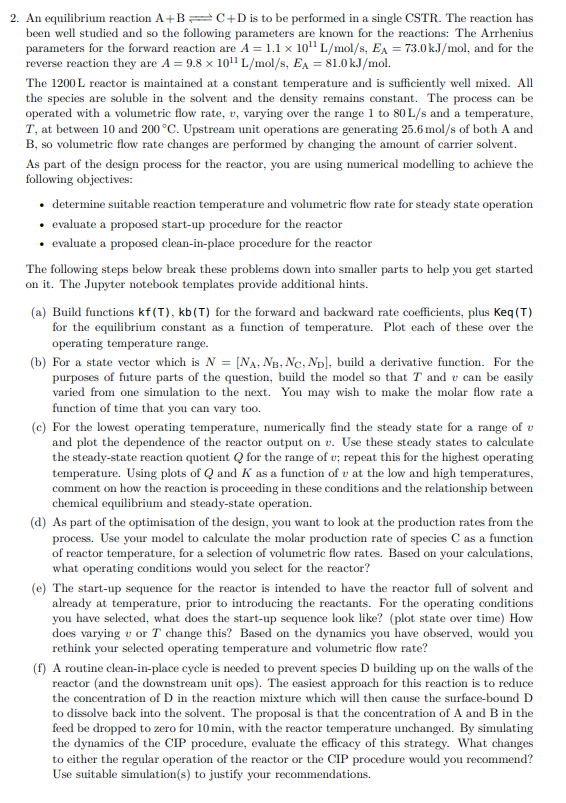
2. An equilibrium reaction A+BC+D is to be performed in a single CSTR. The reaction has been well studied and so the following parameters are known for the reactions: The Arrhenius parameters for the forward reaction are A=1.11011L/mol/s,EA=73.0kJ/mol, and for the reverse reaction they are A=9.81011L/mol/s,EA=81.0kJ/mol. The 1200L reactor is maintained at a constant temperature and is sufficiently well mixed. All the species are soluble in the solvent and the density remains constant. The process can be operated with a volumetric flow rate, v, varying over the range 1 to 80L/s and a temperature, T, at between 10 and 200C. Upstream unit operations are generating 25.6mol/s of both A and B, so volumetric flow rate changes are performed by changing the amount of carrier solvent. As part of the design process for the reactor, you are using numerical modelling to achieve the following objectives: - determine suitable reaction temperature and volumetric flow rate for steady state operation - evaluate a proposed start-up procedure for the reactor - evaluate a proposed clean-in-place procedure for the reactor The following steps below break these problems down into smaller parts to help you get started on it. The Jupyter notebook templates provide additional hints. (a) Build functions kf(T),kb(T) for the forward and backward rate coefficients, plus Keq(T) for the equilibrium constant as a function of temperature. Plot each of these over the operating temperature range. (b) For a state vector which is N=[NA,NB,NC,ND], build a derivative function. For the purposes of future parts of the question, build the model so that T and v can be easily varied from one simulation to the next. You may wish to make the molar flow rate a function of time that you can vary too. (c) For the lowest operating temperature, numerically find the steady state for a range of v and plot the dependence of the reactor output on v. Use these steady states to calculate the steady-state reaction quotient Q for the range of v; repeat this for the highest operating temperature. Using plots of Q and K as a function of v at the low and high temperatures, comment on how the reaction is proceeding in these conditions and the relationship between chemical equilibrium and steady-state operation. (d) As part of the optimisation of the design, you want to look at the production rates from the process. Use your model to calculate the molar production rate of species C as a function of reactor temperature, for a selection of volumetric flow rates. Based on your calculations, what operating conditions would you select for the reactor? (e) The start-up sequence for the reactor is intended to have the reactor full of solvent and already at temperature, prior to introducing the reactants. For the operating conditions you have selected, what does the start-up sequence look like? (plot state over time) How does varying v or T change this? Based on the dynamics you have observed, would you rethink your selected operating temperature and volumetric flow rate? (f) A routine clean-in-place cycle is needed to prevent species D building up on the walls of the reactor (and the downstream unit ops). The easiest approach for this reaction is to reduce the concentration of D in the reaction mixture which will then cause the surface-bound D to dissolve back into the solvent. The proposal is that the concentration of A and B in the feed be dropped to zero for 10min, with the reactor temperature unchanged. By simulating the dynamics of the CIP procedure, evaluate the efficacy of this strategy. What changes to either the regular operation of the reactor or the CIP procedure would you recommend? Use suitable simulation(s) to justify your recommendations







